11 Dietitian-approved Pantry Foods You Should Keep On Hand
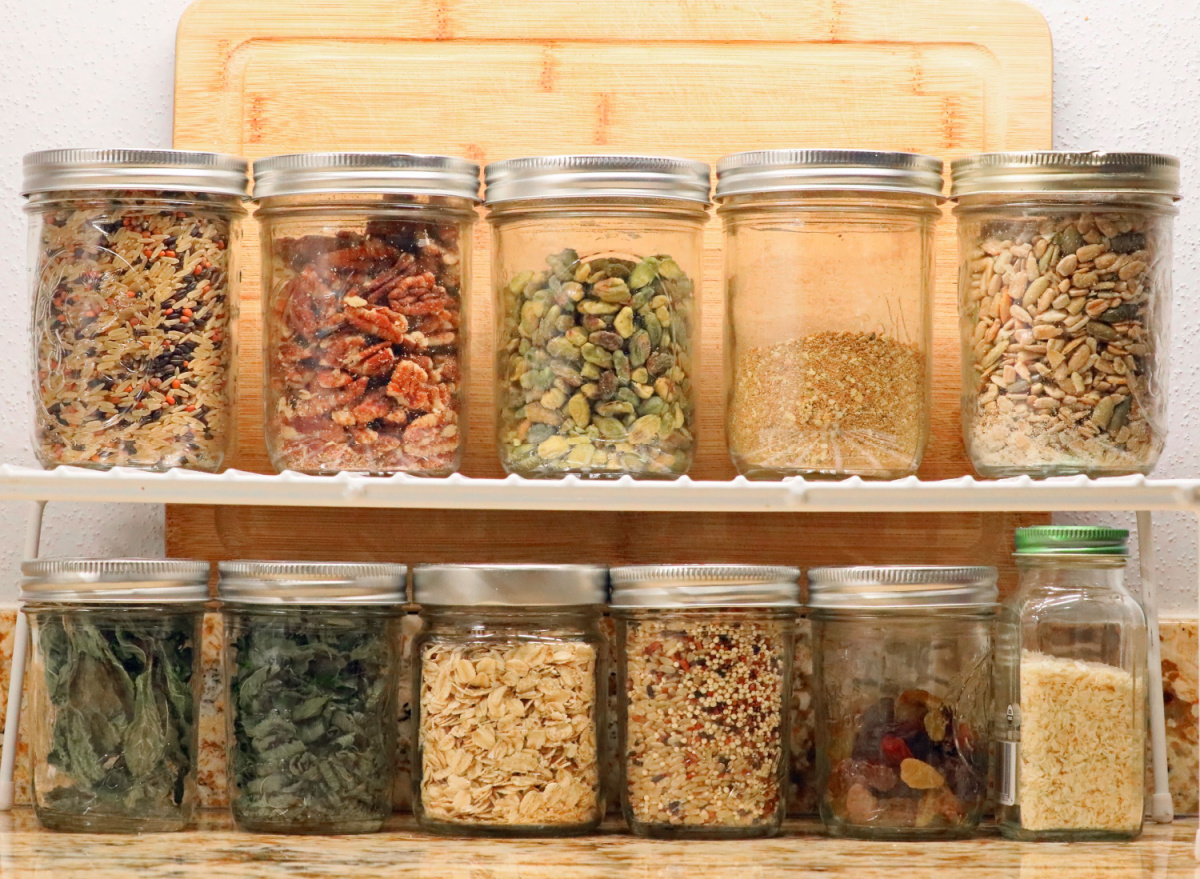
A carpenter never leaves home without a hammer, a square, and a level. A chef will never cook without their favorite knife, whetstone, cast-iron skillet, or food thermometer. Likewise, someone who wants to be prepared to make a healthy meal or snack anytime will always have certain staples in the pantry at the ready. If that someone doesn't have the goods, one might choose to boil up those frankfurters that have been sitting in the deep freeze since the Fourth of July.
Even dietitians order Chinese takeout or pizza in a pinch when there's nothing in the house to eat. But there's rarely a time when these nutrition experts are at a loss for the ingredients to make a quick and healthy meal. They know that one key to good nutrition is having the goods ready to go. So, they stock up on the basic building blocks of healthy eating.
Why leave your healthy diet to chance, when you can peek into the pantries of dietitians? Here are a few pantry staples dietitians love to keep on hand.
Beef jerky
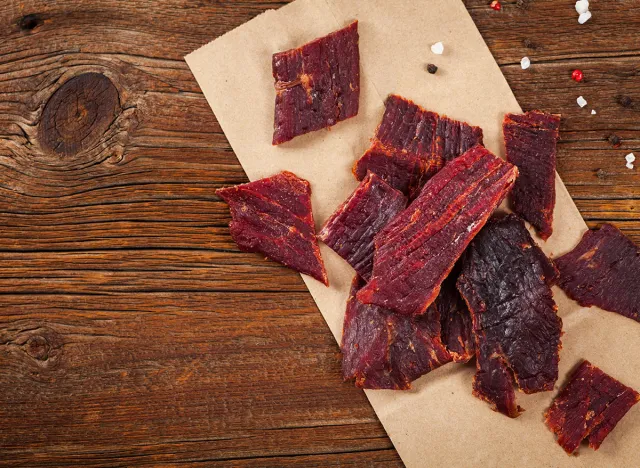
"Portable protein is key if you live on the go like I do," says Amy Goodson, MS, RD, CSSD, LD, the author of The Sports Nutrition Playbook and member of our Expert Medical Board. "Beef jerky is an excellent way to get 10 essential nutrients, including high-quality protein, iron, and zinc, when you need protein quickly. It doesn't have to be kept cold, making it ideal for travel, kid's lunches and snacks, or for running errands."
In fact, protein is one of the best ways to Reduce Risk of Obesity, a New Study Suggests.
A variety of canned veggies
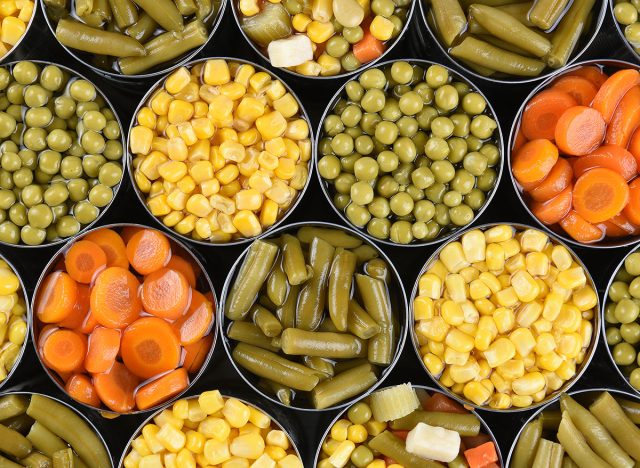
Registered dietitian nutritionist Jen Haugen, RDN, stocks her pantry with canned vegetables that are ready to be dumped into soups, chilis, and pasta dishes.
"I always have plenty of diced tomatoes, especially fire-roasted tomatoes—great for additional vitamin C and lycopene," the author of Dinner, Done! explains. "They add great flavor and color. I also love having canned artichokes on hand to add to pastas or to make a lower calorie version of artichoke dip, as they have quite a bit of fiber per serving."
Tinned tuna or salmon
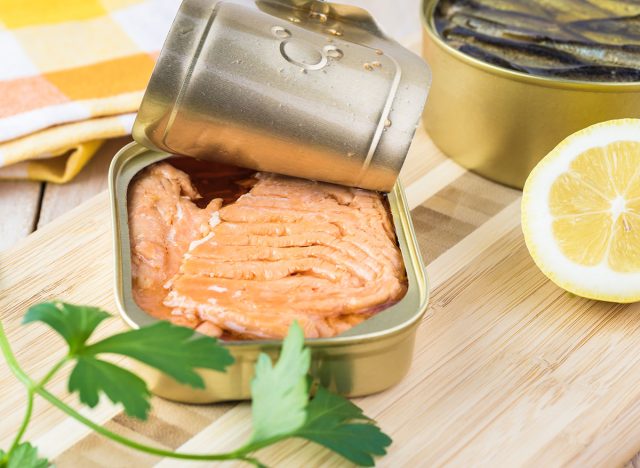
When you can't get to the fishmonger and there's no time to thaw the fish from the freezer, you can still get your protein and omega-3s with a can opener.
"If you have canned salmon or tuna, beans, tomatoes, and 90-second whole grains, you can make an infinite number of meals," says Virginia-based registered dietitian nutritionist Jill Weisenberger, MS, RD, CDCES, creator of the Prediabetes Meal Planning Crash Course.
For example, Weisenberger suggests this simple salmon salad: mix canned salmon with drained marinated artichoke hearts, diced onion, and canned chickpeas. Dress with olive oil and rice vinegar.
Coconut flour
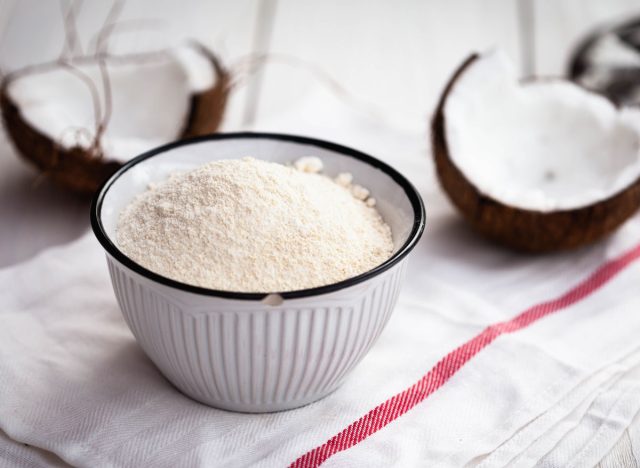
This gluten-free flour is low in carbs and high in fiber, which supports heart and gut health as well as blood sugar stability.
"I keep this in my pantry because it is versatile and also meets my dietary needs and any guest with dietary restrictions," says nutritionist Lisa Richards, creator of a low-sugar, anti-inflammatory diet for gut health called the candida diet. "I use it to boost the nutrition in desserts like gluten-free brownies and muffins. It's also great for pancakes or simply as a breading for items that will go into the air fryer."
Coconut flour absorbs a good amount of the liquid in a recipe due to its high fiber content, so Richards recommends swapping a quarter cup of coconut flour for one cup of regular flour.
Quinoa
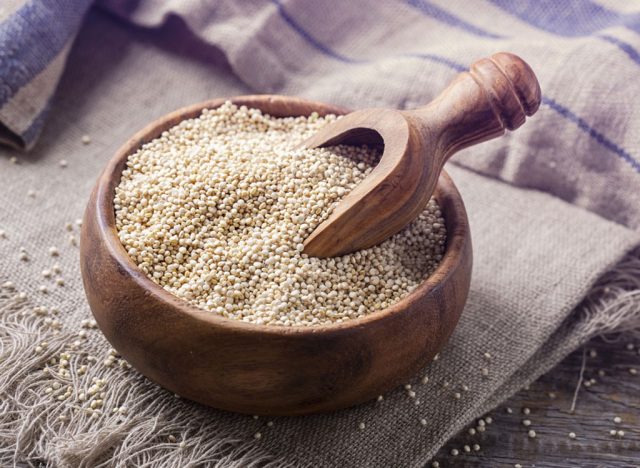
Richards keeps a supply of this protein-rich grain in her pantry because it can be used to complete just about any meal.
"It's a complete plant protein, meaning it contains all nine essential amino acids, which is rare for plant foods," she says. "This grain's protein and fiber keep you feeling full and satisfied for a long time after a meal."
Flaxseeds
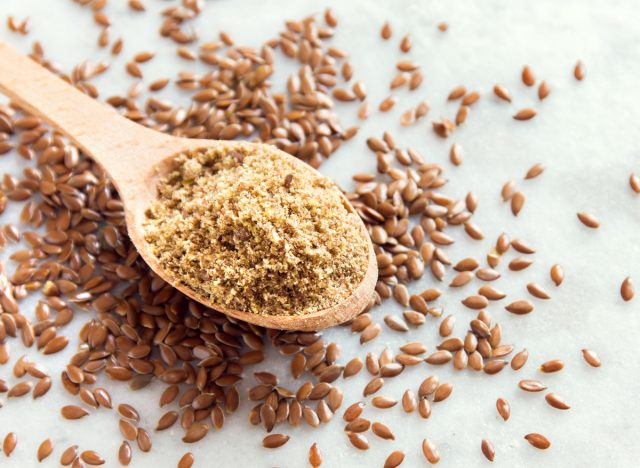
For an added healthy sprinkle to your meals, several dietitians recommended always having flaxseeds and ground flaxseed on hand to blend into smoothies, dust on top of yogurt and cereal, or use in baking. Rich in a plant-based omega-3 fatty acid called alpha-linolenic acid (ALA) and soluble fiber, flaxseed is an easy way to boost the nutritional value of many meals and snacks. Studies suggest that it's an effective ingredient for reducing cholesterol levels, plus it contains antioxidant and anti-inflammatory properties. Read this to learn One Major Effect of Eating Flaxseeds, Says Science.
Dried nori
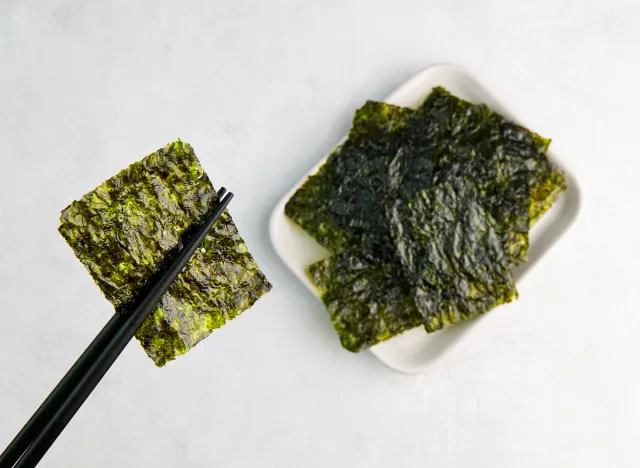
You will always find dried nori seaweed or kombu in the pantry of registered dietitian nutritionist Carly Knowles, RDN, LD.
"These are fantastic sources of micronutrients and minerals that you can easily add to beans or to a soup for depth of flavor and a boost of nutrients," says the author of The Nutritionist's Kitchen. "I also like to crush them and sprinkle on top of a green salad for a salty, mineral-rich addition."
Beans and legumes
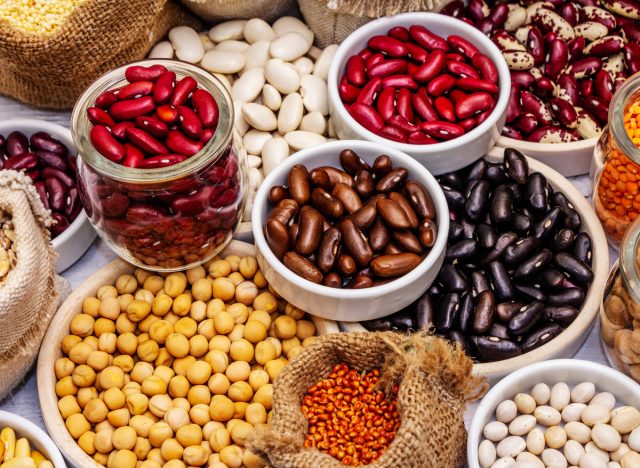
"In my dry pantry, I always have beans and legumes for quick weeknight meals," says Knowles. "I can throw them in my Instant Pot for a fast, nutrient-dense meal. Or, I can open up a can of beans and prepare them in various ways like in this White Bean Pasta with Sun-Dried Tomatoes and Olives."
A variety of whole grains
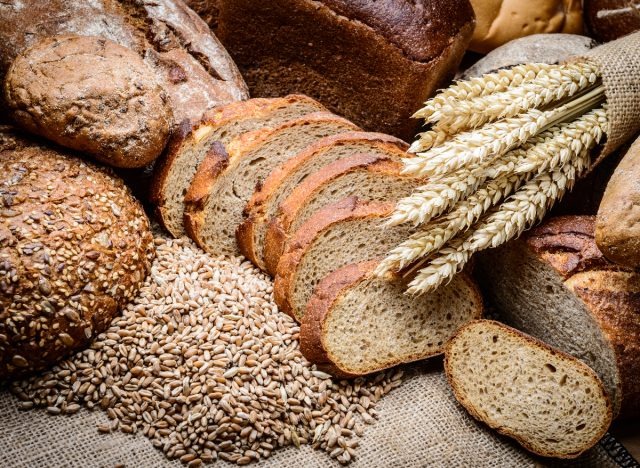
"I stock my pantry with kasha—a cooked grain cereal often made with buckwheat, barley, millet, or rye, whole grain pasta, and steel-cut oats for a high-fiber healthy starch option," says registered dietitian nutritionist Lisa Young, PhD, RDN, author of Finally Full, Finally Slim. "I love starting my day with steel-cut oats so that is top on my list—oatmeal is high in fiber and super satisfying."
Oats are also a source of beta-glucan fiber, which is especially good for gut and heart health. Goodson is also a fan of oats because of their versatility.
"You can use them to make oatmeal, like I do every morning, or for overnight oats. Use them as base for energy bites to make a nutrient-rich snack, and even grind them to make flour which can be used in lots of recipes—even desserts for the holidays," Goodson says.
Bone broth
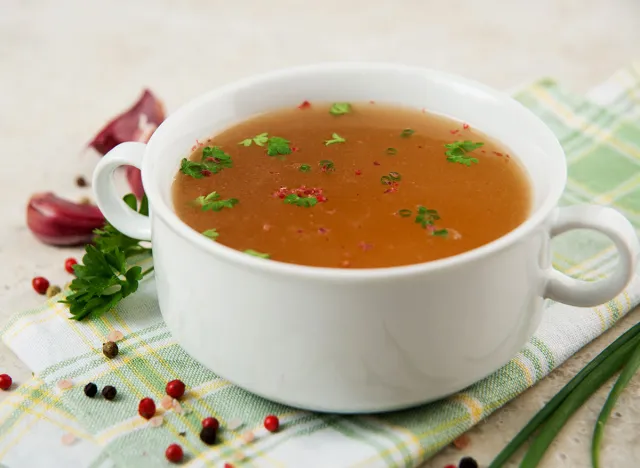
Knowles uses bone broth as a base for soups, to sautée greens, "or to just sip on when I'm wanting a protein-rich snack," she says. Bone broth is rich in protein, collagen, and minerals like iron, calcium, magnesium, and phosphorus.
"I often recommend bone broth to my pregnant patients for the added benefits of gelatin and collagen, which contain a very important amino acid called glycine," Knowles says with regard to this building block for proteins in the body.
Peanut Butter and nuts
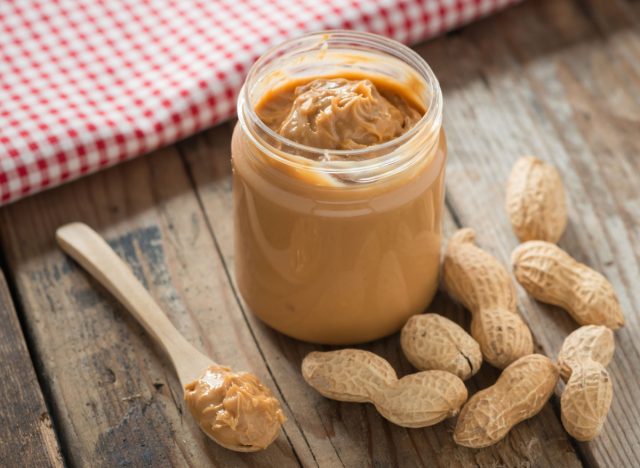
"I eat peanut butter every single day of my life," says Goodson. "It has 4 grams of protein per tablespoon plus healthy fat, a combo that will help you get full faster and stay full longer. Plus, it can be eaten on so many foods like apples and bananas, bread and waffles, crackers, and pretzels, or mixed in oatmeal—my preferred way."
Goodson also stocks her pantry with walnuts, pistachios, almonds, and cashews for the same reasons—they're loaded with protein and healthy fats. Walnuts are a favorite of hers because they're an excellent source of plant-based omega-3 fatty acids.








